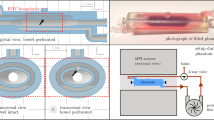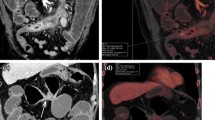Abstract
The purpose of the study was to evaluate multi-detector computed tomography (MDCT) acquired in different acquisitions (unenhanced, and arterial and portal venous phase following intravenous contrast medium) for detection of intestinal bleeding using an experimental bowel model. The model consisted of an injector tube with a perforation placed in a 7-m-long small bowel of a pig. The bowel was filled with water/contrast medium solution of 30–40 HU and was incorporated in a phantom model. Intestinal bleeding in different locations and bleeding velocities varying from zero to 0.75 ml/min (0.05 ml/min increments) were simulated. Twenty-six datasets in simulated unenhanced, arterial and portal venous contrast phase using increasing bleeding velocities and ten negative controls were measured using 64-row MDCT. Two radiologists blinded to the experimental settings evaluated the datasets in a random order. The likelihood of intestinal bleeding was assessed using a 5-point scale with subsequent ROC analysis. The overall sensitivity for detecting bleeding was 0.44 for an arterial acquisition alone, 0.68 for a portal venous acquisition, 0.68 for the combination unenhanced/arterial, 0.72 for unenhanced/portal venous and 0.80 for arterial/portal. Bleeding velocities of above 0.25 ml/min were detected with a sensitivity of 0.59 for arterial, 0.88 for portal venous, 0.85 for unenhanced/arterial, 0.94 for unenhanced/portal venous and 0.97 for arterial/portal venous contrast phase protocols, respectively. The specificity was 1.00. MDCT provides the highest sensitivity and specificity in the detection of intestinal bleeding using arterial and portal venous acquisition in comparison to mono-phase protocols.





Similar content being viewed by others
References
Jaeckle T, Stuber G, Hoffmann MH, Jeltsch M, Schmitz BL, Aschoff AJ (2008) Detection and localization of acute upper and lower gastrointestinal (GI) bleeding with arterial phase multi-detector row helical CT. Eur Radiol 18:1406–1413
Amarteifio E, Sohns C, Heuser M, Pusken M, Lange B, Obenauer S (2008) Detection of gastrointestinal bleeding by using multislice computed tomography-acute and chronic hemorrhages. Clin Imaging 32:1–5
Duchesne J, Jacome T, Serou M et al (2005) CT-angiography for the detection of a lower gastrointestinal bleeding source. Am Surg 71:392–397
Ko HS, Tesdal K, Dominguez E et al (2005) Localization of bleeding using 4-row detector-CT in patients with clinical signs of acute gastrointestinal hemorrhage. Rofo 177:1649–1654
Rajan R, Dhar P, Praseedom RK, Sudhindran S, Moorthy S (2004) Role of contrast CT in acute lower gastrointestinal bleeding. Dig Surg 21:293–296
Sabharwal R, Vladica P, Chou R, Law WP (2006) Helical CT in the diagnosis of acute lower gastrointestinal haemorrhage. Eur J Radiol 58:273–279
Yoon W, Jeong YY, Shin SS et al (2006) Acute massive gastrointestinal bleeding: detection and localization with arterial phase multi-detector row helical CT. Radiology 239:160–167
Ernst O, Bulois P, Saint-Drenant S, Leroy C, Paris JC, Sergent G (2003) Helical CT in acute lower gastrointestinal bleeding. Eur Radiol 13:114–117
Ettorre GC, Francioso G, Garribba AP, Fracella MR, Greco A, Farchi G (1997) Helical CT angiography in gastrointestinal bleeding of obscure origin. AJR Am J Roentgenol 168:727–731
Tew K, Davies RP, Jadun CK, Kew J (2004) MDCT of acute lower gastrointestinal bleeding. AJR Am J Roentgenol 182:427–430
Roy-Choudhury SH, Gallacher DJ, Pilmer J et al (2007) Relative threshold of detection of active arterial bleeding: in vitro comparison of MDCT and digital subtraction angiography. Am J Roentgenol 189:W238–W246
Ketai L (1998) Interventional gastrointestinal radiology. In: Juhl JH, Crummy AB, Kuhlman JE (eds) Paul and Juhl’s essentials of radiologic imaging. 7th edn. Lippincott-Raven, Philadelphia, pp 545–550
Nusbaum M, Baum S (1963) Radiographic demonstration of unknown sites of gastrointestinal bleeding. Surg Forum 13:374–375
Kuhle WG, Sheiman RG (2003) Detection of active colonic hemorrhage with use of helical CT: findings in a swine model. Radiology 228:743–752
Hoedema RE, Luchtefeld MA (2005) The management of lower gastrointestinal hemorrhage. Dis Colon Rectum 48:2010–2024
Dobritz M, Engels HP, Schneider A et al (2009) Evaluation of dual-phase multi-detector-row CT for detection of intestinal bleeding using an experimental bowel model. Eur Radiol 19(4):875–881
Author information
Authors and Affiliations
Corresponding author
Rights and permissions
About this article
Cite this article
Dobritz, M., Engels, HP., Schneider, A. et al. Detection of intestinal bleeding with multi-detector row CT in an experimental setup. How many acquisitions are necessary?. Eur Radiol 19, 2862–2869 (2009). https://doi.org/10.1007/s00330-009-1510-7
Received:
Revised:
Accepted:
Published:
Issue Date:
DOI: https://doi.org/10.1007/s00330-009-1510-7




